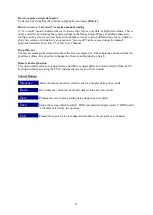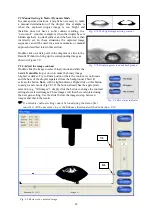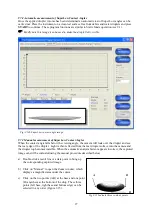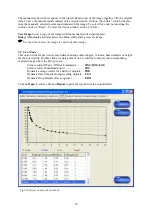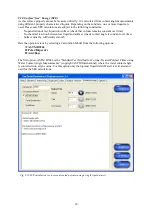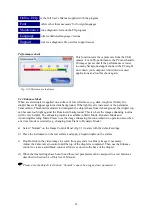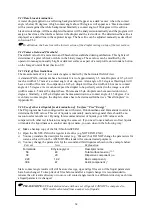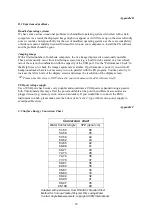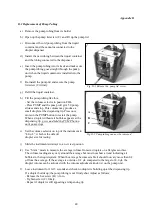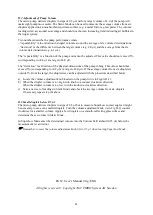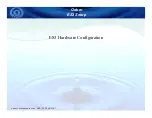
34
9.13 Base Line determination
A water droplet applied on a reflecting background will appear as a dark ’saucer’ when the contact
angle is below 90 degrees. A high contact angle above 90 degrees will appear as a ’black snowman’
with a waist against the white background. Similarly a contact angle of 90 degrees will result in a
black circular shape. All these droplet silhouettes will be analysed automatically and the program will
assign a base line at the interface between the droplet and the test surface. The determined base line is
displayed as a dotted line in the captured image. The base line can be adjusted manually as described
in Section 9.5.2.
By definition, the base line is the lowest section of the droplet resting on top of the test surface.
9.14 Camera Gain and Threshold
The default value for Camera Gain and Threshold is established during calibration. This light level
determines if a pixel is black or white in the binary image. These values can be modified by the
operator to manage unusually bright or dark test surfaces as part of a test profile stored under a button
on the Image Control Panel (Section 9.1).
9.15 Field of View limitations
The measurement of very low contact angles is limited by the horizontal field of view.
A standard PGX+ instrument has a horizontal view of approximately 6.5 mm. Droplets of 0.5 µL will
reach a width of 3.7 mm at a contact angle of six degrees. At an angle of 2.5 degrees this droplet will
have a width of five mm. In comparison a 0.25 µL droplet will reach a width of 4.6 mm at a contact
angle of 1.5 degrees. As we cannot expect the droplet to be perfectly centred in the image, a useful
width is some 4.5 mm at the droplet base. This means 0.5µL droplets can be measured down to 3
degrees. Similarly, a 0.25 µL droplet can be measured down to a contact angle of 1.5 degrees. For
even lower contact angles, the droplet volume has to be decreased further (see “Small droplets” in
Appendix D).
9.16 Use of other test liquids for determination of ‘Surface “Free” Energy’
The PG program has been configured for use with water, Diiodomethane and Formamide in order to
determine the SFE values. This set of liquids is commonly used and in general there should be no
reason to select another set. By using this recommended set of liquids your SFE values can be
compared with other test laboratories using the same set. If you need to use another set of test liquids
or translate the liquid names to another descriptor name, you can do so in the following way:
a)
Make a backup copy of the file \fibro\bin\SFE.INI
b)
Open the file SFE.INI with a regular text editor (e.g. NOTEPAD.EXE)
c)
You may translate the descriptor for water (e.g. ‘Wasser’) but DO NOT change the parameters for
water, as this will ruin the ASTM D5946 standard for corona treated polymers.
d)
You may change the parameters for the second and third liquids as shown in the example below:
Current
New
Explanation
Formamide
Ethylene glycol
Descriptor name
58
48
Total surface tension
TOT
39
29
Dispersive component
LW
2.28
1.92
Basic component
-
39.6
47
Acidic component
+
Static contact angle results will still be stored as wgs, dgs and fgs files even if the liquid parameters
have been changed. To keep track of files before and after a liquid change it is recommended to
rename the old results directory or to move old contact angle results to a different directory each time
a liquid parameter is changed.
PLEASE NOTE: SFE calculations done with one set of liquids CANNOT be compared to
SFE results calculated from another set of liquids;


